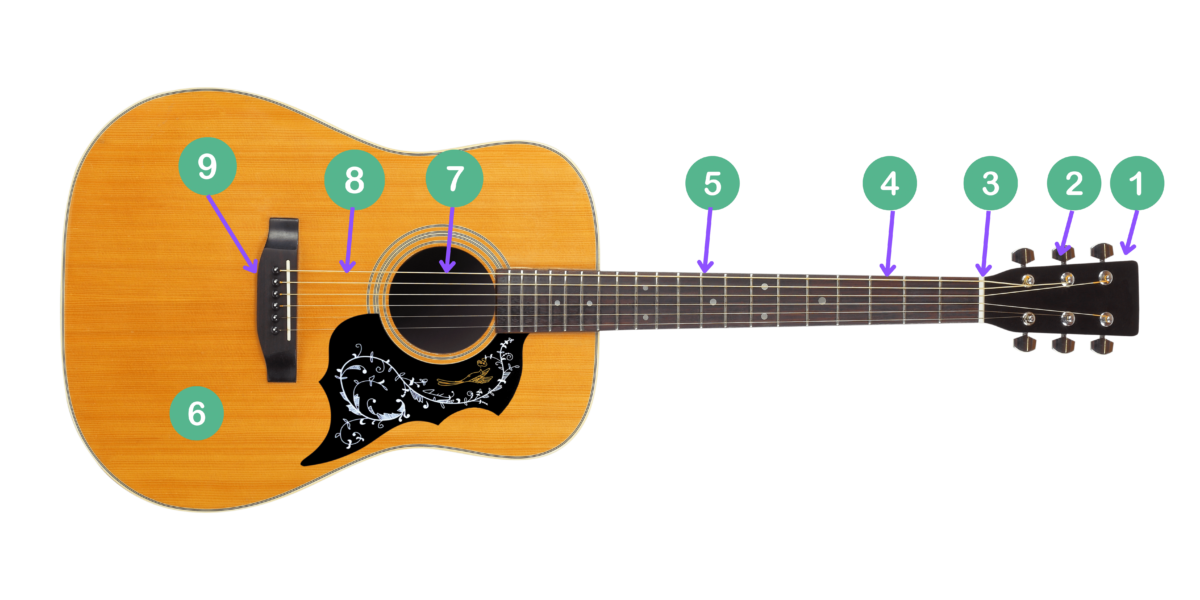How to Play Guitar for Beginners

Learn how to play the guitar for beginners! This article covers everything from the mechanics of the guitar to choosing a teaching method and mastering the fundamentals.
When you see one of the great guitarists on stage, like Jimmi Hendrix or Pat Metheney, the guitar looks like an extension of their body and sounds like an extension of their voice. It seems entirely out of reach.
It’s easy to forget that they, too, started from the beginning.
Every incredible journey starts with small steps, and nobody walks it alone. In this article, we hope to help you take your first steps toward playing guitar. We’ll start you on all the initial stages, like understanding how the instrument works, the fundamentals of playing guitar, and designing a learning approach.
What do you need before starting?
Make sure you have the following:
- A guitar (for playing)
- A tuner (for tuning)
- A pick (for picking)
- A notebook and pen (for writing important notes during your lesson or practice session)
Do you know how to hold the guitar? This is important. Unless you’re left-handed, you want to have the head in the left hand and the body resting on the leg, with a hug from the right. Not familiar with these terms?
Guitar anatomy.
Knowing your guitar’s body is important to use it correctly and care for its needs.

- Headstock: This is the head of the guitar. Small and compact, but it’s where the tuning of the whole system lives.
- Tuning pegs: These are small nobs on either side of the headstock. If you turn them right, the strings loosen, and their pitch gets lower. If you turn them left, the strings tighten, and their pitch increases.
- Nut: All the strings are tied to this small fragment that separates the neck from the head.
- Neck: Long like a giraffe, the guitar neck connects the headstock to the body, and the strings stretch across it from the tuning pegs towards the end of the guitar’s body.
- Fretboard: The neck contains lines that create columns across the strings. This makes a grid which is called the fretboard. Each fret or column raises the pitch by a semitone by holding the string down in that fret while you pick or strum the note. This is how we play chords on guitar.
- Body: This is the beautiful wooden part of the instrument, which can be found in an infinite number of colors, styles, and shapes. Each shape gives it a unique sound.
- Soundhole: This is exactly where the heart would be in the body – okay, maybe a little less to the left. You’ll find the sound hole in the body’s upper center. This is how the strings’ vibration enters the body and resonates with sound.
- Strings: Six of them, each with slightly different material and thickness giving them different pitch ranges. The lower strings are thicker and heavier. The extent to which they pull along the neck and are tuned on the headstock is what determines their final pitch.
- Saddle: A small piece on the guitar’s body, below the soundhole, where you tie the strings. The tension of the strings pulled between the saddle and the headstock makes the music happen!
Guitar out of tune? Check out How to Tune a Guitar.
Basic guitar chords.
Let’s go back to basics for a second. Do you know what a chord is?
A chord is when you play two or more notes simultaneously. The sound of multiple notes together creates harmony, a building block of all music. We make chords from scales (a series of seven notes played consecutively) and use a simple numbering system.
Each of the six strings on the guitar tunes to a different pitch. Playing the strings open as they are doesn’t make a chord (technically, it does, but it’s not a very nice one). When we change the strings’ pitches by pressing our left-hand fingers on the fretboard, we can make so many different kinds of chords.
Some chords are tricky to play because they require complicated finger positions on the fretboard. Others only need two or three fingers and are super accessible for beginners.
Knowing even three of four chords on the guitar can open a whole world of music under your fingers, but an excellent place to start is with the different types of guitar chords.
There are three main types of chords that we play on the guitar:
Open chords
Open chords resonate beautifully on the guitar. We call them ‘open’ because they require very few fingers, leaving most strings open in their natural tuning. Pressing on the strings creates tension which changes the pitch – but that tension also limits the resonance of the strings.
Open strings vibrate wide and far, creating a beautiful warm guitar sound. There is an acronym to remember the names of the primary open chords on guitar – CAGED.
Power chords
Power chords are simple and robust because they only use two notes and usually only two or three fingers. A power chord is when strings are pressed on the fretboard and sometimes muted altogether so that the only remaining notes are the root note and the fifth of the chord.
This creates a “five chord” in general musical terms and a power chord on the guitar. We usually play them on electric guitar, where we can distort and amplify the sound to add even more power!
Barre chords
Barre chords are when the side of one of the fingers presses down on a whole column of the fretboard. As you can imagine, this requires finger strength and takes time to develop.
By blocking out a whole column, you raise the strings’ pitch by one semitone. On top of that, you usually need another one or two fingers to press down on specific squares to complete the chord. These chords are instrumental because they mostly use a one-hand shape, allowing you to move your fingers smoothly up and down the fretboard.
Guitar strumming.
When you see a pro guitarist strumming, you probably think: “That looks incredibly natural. I can probably do that!” But then you try, and it’s super awkward. Learning strumming patterns is one of those things which feels like learning to walk – incredibly foreign and overwhelming at first, but it very quickly becomes second nature.
Part of learning to play guitar involves strumming patterns. These are different combinations of up-stroke and down-stroke movements of the right hand on the strings. Some strumming patterns are even and intuitive. Others are irregular and require a lot of practice until it sinks into your muscle memory.
Strumming tip
Make sure your wrist is loose and that the strumming pattern happens through the power of inertia. If you are tense in your hand when strumming, you’ll very quickly get tired and possibly even injured.
But it’s not just for your fingers! Training your ears to identify the up and down strokes which comprise strumming patterns is an important part of learning the language of the guitar. It helps you pick up songs easily and groove with the instrument.
You can strum using a pick or using your fingers. A pick is usually better for songs where you want more volume, power, and momentum. Fingers are ideal for something more gentle or folky. Ensure you angle the pick correctly towards the strings, so it doesn’t accidentally hit the wrong strings while you’re playing.
Scales and finger exercises.
As we mentioned earlier, scales are a series of seven notes. Most songs you know were born from the major scale, which has become the iconic sound of Western music. If you want to dive deep into the guitar, begin by learning to play scales starting on all twelve notes in different positions on the fretboard. This get’s your fingers nimble and helps you learn the fretboard like the map of your hometown or the palm of your hand. There are many online resources to learn about guitar scales and applications, such as Simply Tune, to guide you through your guitar journey.
When practicing scales, think of them like finger exercises. Like with any training, starting slowly and building gradually is essential. Find a pace that enables accuracy and consistency rather than trying to go 200km/h straight off the bat. Remember to do lots of repetition – the idea is to be precise and effortless, so keep repeating specific phrases and scales until that’s how it feels and sounds. Take breaks to stretch your fingers backward, forwards, and sideways. We want to build agility and finesse like the hands of a surgeon, but without creating tension or blockages.
Start your journey with a song.
The moment you finally play a song on guitar brings joy like no other. Relish the moment and immerse yourself in the music that you make. This moment can be pretty anticlimactic if you don’t choose the right tune for where you’re at. Here’s our list of the best songs for beginners to learn on guitar:
- Stay With Me (Sam Smith)
- Hallelujah (Leonard Cohen)
- Twist and Shout (The Beatles)
- Elenoar Rigby (The Beatles)
- Chasing Cars (Snow Patrol)
- Skinny Love (Bon Iver)
You can find some of these songs and more on the Simply Tune guitar app for a comprehensive learning experience on the guitar.









